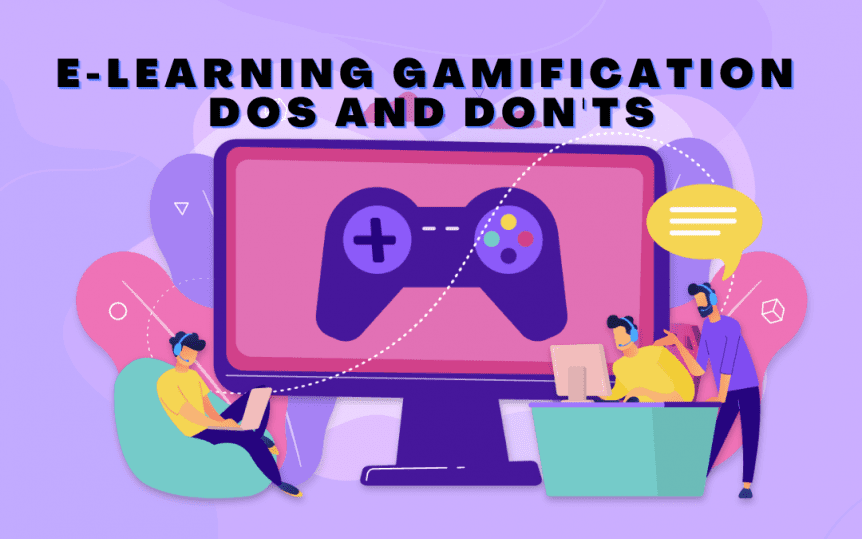E-Learning Gamification Dos and Don’ts
Gamification involves adding features to your e-learning courses borrowed from the gaming industry. The aim is to enhance engagement, improve the learning experience, and enhance knowledge retention rates.
However, simply adding gamified elements to your e-learning course is not enough. As with all aspects of e-learning design and development, gamification must be done right. Here are nine don’ts and 10 dos when using gamification in e-learning.
E-Learning Gamification Don’ts
Don’t Start with Gamification
Gamification shouldn’t be the starting point for your e-learning course. Instead, you should focus initially on business objectives, learning objectives, and the results you want to achieve. From there, you should look at the best way to achieve these goals. Only at this stage should you consider gamification.
Don’t Make It Just About the Game
Taking the above point a step further, even if a gamified element is deemed to be suitable, make sure you look at why you want to include it. For example, is it to present new information or reinforce previous information? Do you want to add competition to the e-learning course, or will the gamified element give the learner the opportunity to practice what they have learned?
Don’t Use Gamification for the Sake of It
Gamification is not suitable in all situations. For example, gamified elements might not work for your intended audience, or the topic might not be suitable. Just because gamification is effective in general, doesn’t mean you should automatically try to include it in all e-learning courses.
Don’t Get Too Complicated
The best approach with gamified elements in e-learning courses is to keep the mechanics as simple as possible. For example, if part of your gamified approach is to give learners badges and rewards, don’t go overboard in the range of rewards, levels, or badges that learners can earn. The focus should instead be on the learning experience.
Don’t Make Game Elements Too Hard
When gamified elements in an e-learning course are too difficult, you risk frustrating and alienating learners. This will have the opposite effect from what you intend, i.e., learners will become less engaged with the training.
Don’t Overdo Competition
Leaderboards are a common feature when gamifying parts of e-learning courses. However, in some situations, leaderboards can be demotivating, particularly for those who are not doing well. Leaderboards can also result in undesired behaviours, such as cheating, especially if there are real-world rewards involved (such as time off work or prizes).
Therefore, it is important to think carefully about why you are including a leaderboard.
Don’t Forget It’s About Learning
Always remember with gamification that it is all about learning. If the gamified element is not helping people learn, it probably shouldn’t be included.
Don’t Overdo Badges and Rewards
Badges and rewards can make e-learning courses more engaging but overdoing them can have the opposite effect. They can make e-learning courses unnecessarily complicated, for example, and they can be distracting, where people are more focused on earning rewards than learning.
It’s also important to remember that making mistakes is part of learning. By focusing too much on badges and rewards, the idea of making and learning from mistakes can be lost.
Don’t Neglect Other Parts of the Course
Gamified elements can take up large amounts of time and resources during e-learning development to the point that other parts of the course become neglected.
E-Learning Gamification Dos
Do Start with Business and Learning Objectives
Your focus should always be on the results you want to achieve. Gamified elements should be a means to an end.
Do Provide Good Instructions
The last thing you want is to go to the trouble of creating a gamified element in your e-learning course only for learners to be confused about what they should do. Providing instructions can help.
Do Make Game Elements Fun
Gamification is about learning, but it should also bring fun to the e-learning course. If the gamified elements are not fun, they won’t have the impact you are hoping for.
Do Add Urgency
Urgency is an important part of many mainstream games as it makes the games more interesting, fun, and exciting. You should bring urgency to the gamified elements in your e-learning courses when it makes sense to do so. Using timers is one of the most common approaches.
Do Make Game Elements a Learning Experience
When planning and designing gamified elements, always remain focused on helping people learn and understand the topic of the course.
Do Make the Design Look Professional
Learners have high expectations when it comes to e-learning design, aesthetics, navigation, and performance. As a result, make sure any gamified elements you include are professionally developed and designed.
Do Think About Your Audience
One of the most important questions you should consider when thinking about using gamification in an e-learning course is how will learners respond. For example, younger audiences who have grown up with games on phones and other devices might be more open to gamified elements than older audiences who don’t have the same lived experience.
Do Analyse Results
This point goes back to the earlier points about focusing on business objectives and learning outcomes. Part of this is analysing whether the gamified parts of the course delivered on expectations.
Do Offer Badges and Rewards
We mentioned in an earlier point about being careful not to go overboard when adding badges and rewards. It is also important to say they can be a very effective tool, so they should be included wherever it makes sense to do so.
Do Make It Social
You can enhance the learner experience by adding social sharing buttons and other social media features to the gamified elements of your e-learning course.
Getting Gamification Right
Gamification can raise the quality of your e-learning courses to another level, helping to improve your overall training strategy. However, you need to include gamified elements for the right reasons, and the implementation has to be done properly. Following the above dos and don’ts will help.
